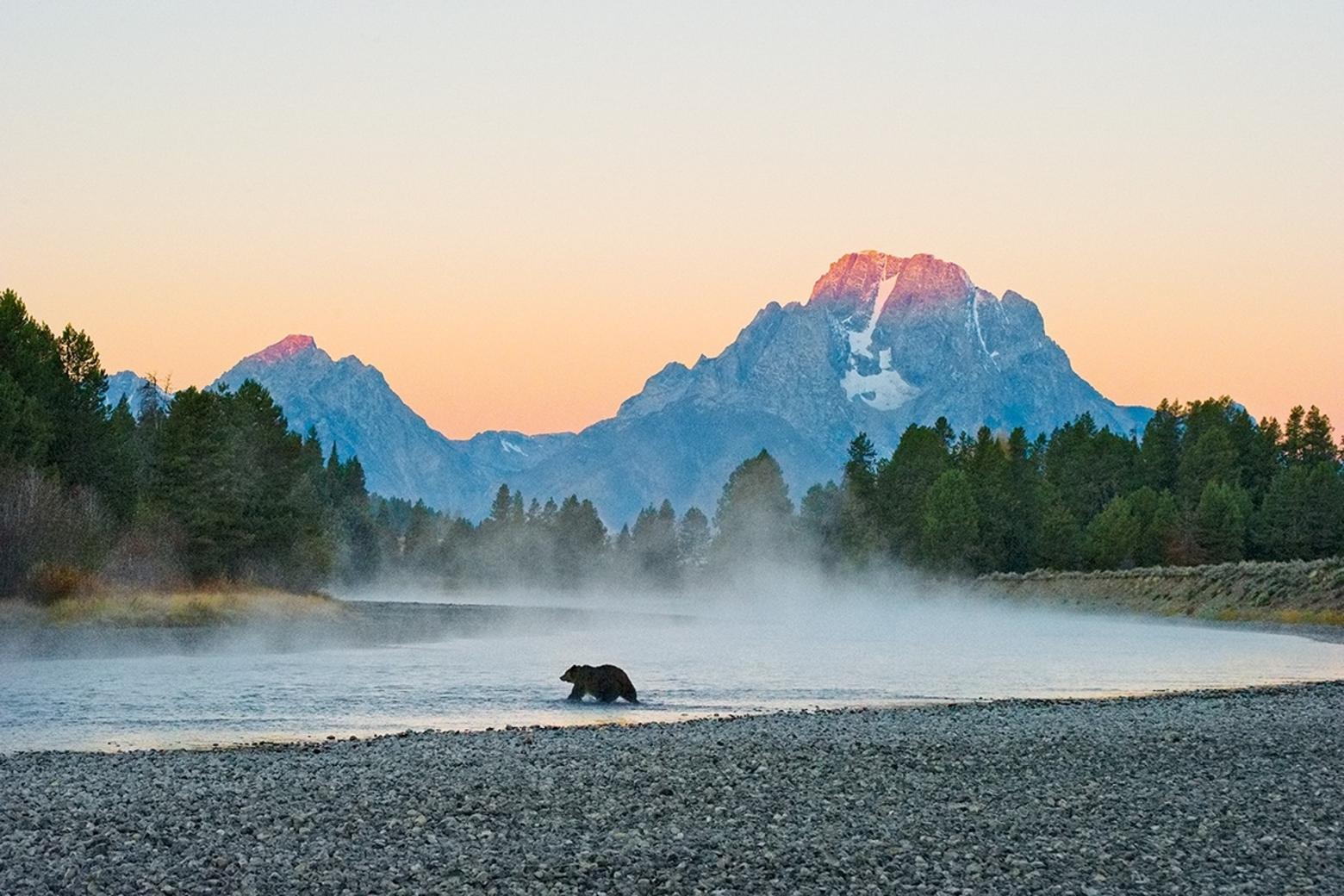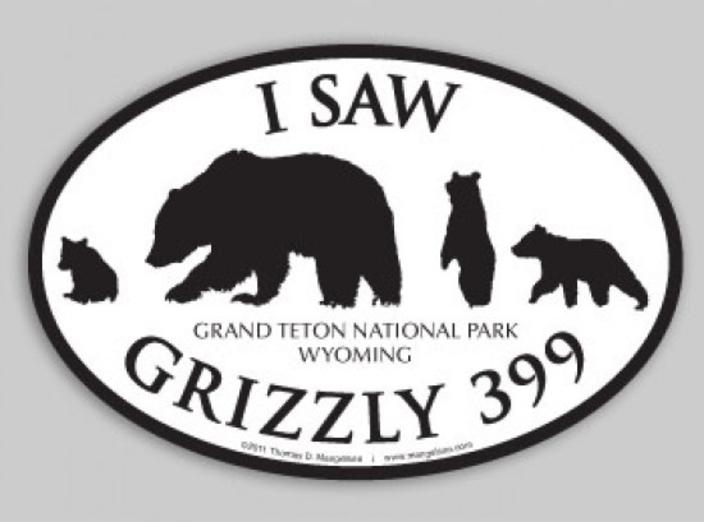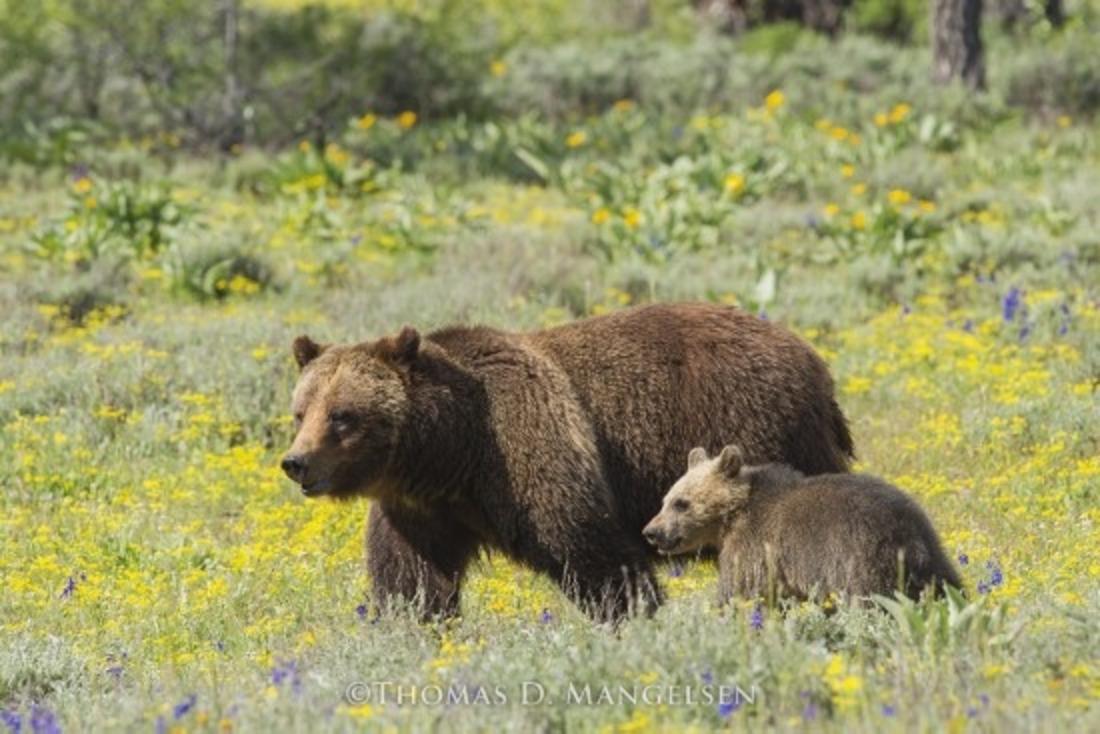Back to StoriesCharting The Rise Of A Famous Grizzly Bear Mother In Jackson Hole
October 3, 2017
Charting The Rise Of A Famous Grizzly Bear Mother In Jackson HoleBefore Jackson Hole Had Grizzly 399, There Was Grizzly Mama 474
Living in the Greater Yellowstone Ecosystem for a long while and writing about it,
words yield snapshots of how things used to be. Eleven years ago, I penned a New West column titled "It's a bear soap opera in the northern valley."
How soon we forget that once upon a time not so long ago, Jackson Hole Grizzly 399, today's vaunted matriarch of Pilgrim Creek, was just another female bear with cubs and a radio collar around her neck.
It has been her remarkable longevity, beating the odds of survival, that has made her famous.
Neither 399 nor we humans in 2006 could have imagined how the ensuing
years would unfold, catapulting her to global recognition as an emblem
for her species.
Yet it still amazes me how many old-guard
politicians in Wyoming, including Gov. Matt Mead and all three members of
Wyoming's Congressional Delegation, just can't allow themselves to get excited
about the presence of grizzly bears in Jackson Hole.
If they mention them at all, it's with grudge and glower, never glowingly, as if they can't accept that grizzly recovery and
wolf recovery in Wyoming is a good thing—that it has generated global goodwill
for their state, which should make them proud; that, if they are being
honest, it has netted a zillion dollars more for the coffers of local
economies than any costs incurred by the state in grizzly management,
Grizzlies—and wolves—are not driving outfitters
or ranchers or anyone else out of business. They are not killing more livestock
than the weather or natural illness do. They have not halted economic progress. They are not eating kids off of
playgrounds, or spreading diseases, or promoting Obamacare, waging wars on
Wyoming coal, or registering to vote as Democrats in the next election.
So what is really behind the hostility toward predators. If there isn't a compelling economic reason or safety reason, why all of this culturally-reinforced
animus?
I am friendly with several ranchers in Wyoming whose attitude toward
predators is generally live and let live—unless grizzlies and wolves become a
problem, but most of the time, they say, they aren't.
This summer, those ranchers took visiting
guests and their children bear watching in Grand Teton National Park. Why?
Their out of state guests had heard about Jackson Hole's bears and
thought it "was pretty cool to see them".
During the 1970s on my first family vacation
west, I, as a teenager, became the proud owner of a "Go Climb A
Glacier" t-shirt after I trekked across a snowfield which already has
vanished due to climate change in Glacier National Park. I wore the shirt until it became ragged. For me, it was a reminder of my connection to
big wild nature.
Today, people come from all over the world and
are proud to commemorate a bear sighting in Jackson Hole by taking a "I
Saw Grizzly 399" sticker home with them. That's what the guests of my rancher friends did.
When I wrote the column, below, in 2006, 399 was 10 years old and had her first triplets. She came on my radar screen almost by accident, for I was in the field with members of the Interagency Grizzly Bear Study Team, asking questions about a different collared grizzly bear female. She is now just a footnote from the past.
399, meanwhile, is today 21 years old with two cubs of the year and has 17
total bruins in her bloodline, about half of which have died in various kinds
of run-ins with people. I realize now that, had circumstances gone differently, the book Grizzlies of Pilgrim Creek featuring photographs by Tom Mangelsen, could have featured a different bear mother. Or maybe the book wouldn't have happened at all.
While some agency folk have attempted to
dismiss bruins like 399 as "celebrity bears", the fact is that their
stories have galvanized public interest, leaving more citizens interested in
the conservation of grizzly bears than ever would have cared otherwise. And
when the public cares, it makes public land management agencies more relevant.
The fact that grizzlies persist today in the
Greater Yellowstone Ecosystem is a miracle, a success worth touting and one in constant need of improving upon.
Here is how the column read in 2006:
° ° °
Last autumn, I crawled into a grizzly bear day bed.
I had begun research for a story about Ursus arctos
horribilis, joining members of the Yellowstone Grizzly Bear Study Team in
the backcountry just east of Jackson Lake.
The study team, whose scientific origins go back to the
1950s when pioneering biologists Frank and John Craighead headquartered
themselves in the Tetons, has an ongoing monitoring effort that is delivering
valuable information about how bears live and where they prowl.
Based out of a trailer parked at Colter Bay, Shannon
Podruzny and her crew have gathered thousands of data points from collared
bears that are being tracked via satellite and through radio telemetry.
One of the fascinating subplots involves the wanderings of
Bear 474, a female griz of breeding age.
According to Podruzny, she's part of an ursid soap opera
playing out along the northern tier of Jackson Hole roughly between the western
side of the Tetons in Idaho and the deepest roadless terrain in the Teton
Wilderness.
In daily episodes of "As The Grizzly World Turns,"
females with cubs, which represent the most valuable component of the larger
ecosystem’s bear population, are demonstrating what bears do to stay out of
trouble.
These family unit matriarchs are teaching offspring how to
kill elk calves; they are exposing them
to the full smorgasbord of natural plants and other prey; and they're mentoring impressionable cubs how
to survive discreetly in a realm populated by people.
By and large, says Chuck Schwartz, head of the Grizzly Bear
Study Team based in Bozeman, the mamas are doing a pretty good job of
tolerating humans. Now it's our turn to
keep thinking about how we can continue to do our part as the bear population
expands.
Schwartz does not concern himself with the politics of
delisting the Yellowstone griz population, which is to say, supporting or
decrying the Fish and Wildlife Service's proposal to remove this famous group
of bears from federal protection under the Endangered Species Act.
It's clear that the states, the land management agencies,
conservationists, natural resource extraction groups, hunters, motorized
recreationists and others are engaged in that battle which is certain to be
resolved one day only in court.
In the meantime, the study team is quietly going about its
work to divine insights into bear ecology, which ultimately forms the baseline
for how management decisions in the future will be made.
This spring, researchers were hoping that Bear 474,
following a series of "romantic interludes" with suiting males, might
emerge from her den near the northern end of Jackson Lake with cubs.
But that didn't happen. 474 is back but without young. Instead, another female being closely tracked
by Podruzny is Bear 399, who has three cubs and is inhabiting the environs
around Colter Bay.
“We can't just close our eyes and hope it works out. That is naive. Society has already tried that approach. We almost lost the bear." —Chuck Schwartz
While making extrapolations based on a single bear mother is
unwise, what can be suggested is that a female with three cubs is a good thing;
it means 399 had plenty of food to get her fat enough last fall to carry
through a successful pregnancy; and, if she gets through the rest of this year
without having a conflict with tourists or getting shot by hunters, her
attentive parenting will likely be passed on to another generation.
Now and decades from now, the fate of the Greater
Yellowstone grizzly population will be assessed based upon numbers of bears and
security of prime habitat. Yet as
Podruzny and Schwartz note, healthy populations are built one family unit at a
time.
If the Grizzly Bear Study Team is zealous about anything, it
is in hammering home the points that human respect for bears, and our
willingness to make room for them, will determine their persistence, which,
based upon surveys, a majority of Americans support.
"We have to understand how
the bear interacts with its environment and how we affect its habitat in order
to ensure the long-term survival of the species,” he said. “We can't just close
our eyes and hope it works out. That is
naive. Society has already tried that approach. We almost lost the bear."
Related Stories
March 20, 2019
Naturalist Says Outdoor Recreation Can Have Huge Impacts On Wildlife
Mountain bikers and hikers with dogs can bring huge spatial intrusions into wildlife habitat
September 23, 2017
Grizzlies Deserve More Than Bullets
Phil Knight saw his first Yellowstone grizzly 35 years ago. After watching bear numbers climb, he says recovery should not be...
January 29, 2018
The Essential Role Of Eco-Capitalism In Saving The Best That Remains
Greater Yellowstone's rich tapestry will be won—or lost—based on what businesspeople do next






